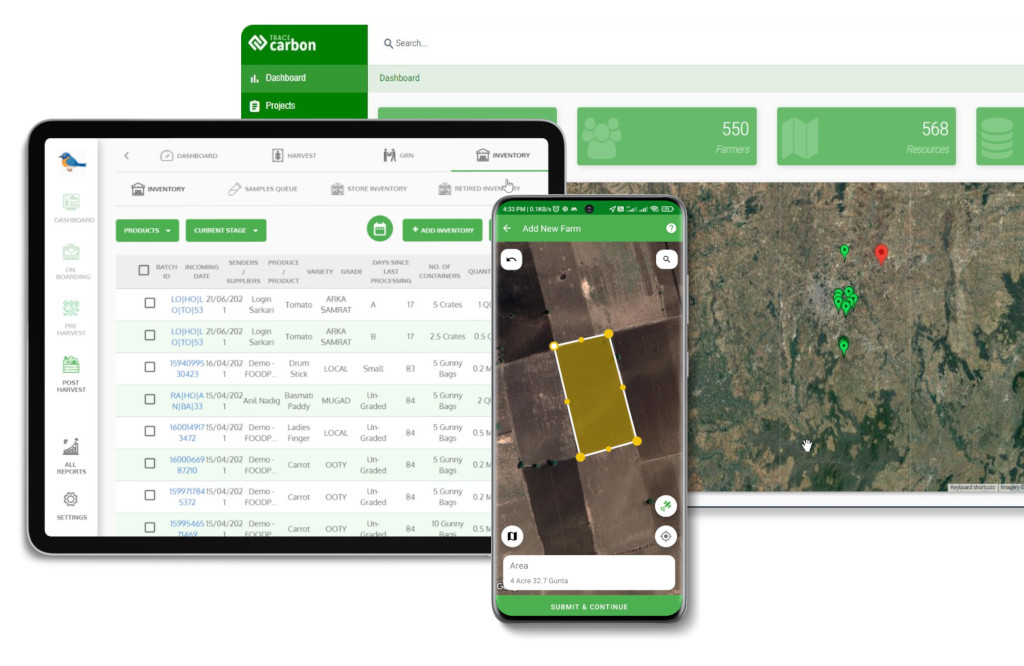Contact: +91 99725 24322 |
Menu
Menu
Quick summary: Mill-level rice traceability is now critical for compliance. Learn why most supply chains fail at the mill — and how to fix it with TraceX.

The rice industry is waking up to a new reality: compliance is no longer just a farm-level concern. With increasing buyer demands for sustainability, and the rise of ESG-linked supply chain audits, rice exporters and processors can no longer afford to overlook the crucial role of mills in the traceability chain. This is where mill-level rice traceability becomes the missing (and mission-critical) link.
While many traceability efforts stop at the farm, the real compliance breakdown often happens at the mill — where paddy from hundreds of smallholders is aggregated, milled, graded, and shipped out. Without proper mill-level documentation, you lose your ability to prove deforestation-free sourcing, fair trade practices, or batch-level traceability. In this blog, we break down what true mill-level traceability looks like, why it’s essential for audit-ready compliance, and how leading agri-businesses are using technology to connect the dots — from farmer tokens to export containers.
Key Takeaways
For years, traceability in rice supply chains has been mostly about farm-level data: land records, farmer KYC, sowing dates, input logs, and harvest declarations.
But that’s just half the story.
The moment the paddy leaves the farm, something critical happens — it enters the mill. And from that point on, unless you have a system in place, the traceability trail gets blurry.
So, what exactly is mill-level traceability?
It’s the ability to track how paddy from multiple smallholders is:
Each of these steps is a point of transformation — and with transformation, comes risk:
If you don’t have answers to these questions, neither will your buyers — or your auditors.
The result? You’re sitting on a mountain of product, with no digital trail to back it up.
And in today’s compliance landscape — that’s a problem.
Buyers are no longer just asking for farm data.
They want to know:
Mill-level traceability isn’t a “nice-to-have” anymore — it’s your proof of integrity.
If you’re:
Then your goal isn’t just data.
Your goal is trust — in the eyes of your buyer, your regulator, and your own team.
And that trust starts (or breaks) at the mill.
Once upon a time, buyers cared mostly about where your rice came from. Now? They care about what happened to it at every step — especially at the mill.
That’s because mills are where everything converges: procurement from hundreds (or thousands) of farmers, crop grading, sorting, drying, polishing, packing, and dispatch. It’s also where traceability and compliance can break down the fastest — if you’re not careful.
If you’re working with:
… then you already know these certifications don’t just want farmer declarations. They want input vs output reconciliation at the mill.
How many tons of certified organic paddy came in?
How many tons of rice went out?
If there’s a mismatch, they want to know why.
No guesses. No estimations. Just batch-level proof.
Even if you’re not in certified programs, you’re still facing rising ESG pressure:
If you’re exporting to the EU, UK, or premium buyers in Asia or North America, these data points are becoming deal-breakers.
And here’s the kicker: Most mills aren’t tracking any of this digitally.
That makes ESG reporting incomplete — or, worse, unverifiable.
This isn’t about being “non-compliant.”
This is about losing visibility when it matters most — and realizing too late that your traceability stops before the buyer starts asking questions.
And that’s the heart of the issue:
You can’t export credibility if your mill can’t back it up.
You can have the best farm-level traceability in the world — digital plots, farmer KYC, declarations, the whole package. But if your mill is running on pen and paper, the chain breaks right there.
Let’s look at the real-world issues that most agri businesses don’t talk about publicly, but everyone struggles with behind the scenes.
Picture this:
A farmer walks into the mill with 2 bags of paddy.
A field agent jots down their name in a register.
Weight? Approximate.
Variety? Assumed.
Linked to which plot or agreement? Nowhere.
By the end of the day, you have 100 farmers, 200 bags, and no digital trail.
That’s a data black hole.
And come audit season, all you have are registers, torn slips, and hopes that someone remembers the numbers correctly.
This is the big one.
You’ve spent time and resources issuing procurement tokens to trace what comes in from the field.
But once those bags enter the mill?
They’re dumped, dried, and milled in pooled batches — with no way to match back to the farmer.
Your compliance report says:
“This batch came from certified farmers.”
The buyer asks:
“Can you show us which ones?”
You freeze.
Grading is supposed to be your quality firewall.
But at many mills, it’s reduced to:
Here’s the problem:
Certifications like Organic, FairTrade, and SRP require grading to be logged and reconcilable.
They want to know:
If your grading process isn’t standardized, logged, and integrated — you’re setting yourself up for non-compliance risk.
We get it — mills are operational war zones during harvest.
Speed is the name of the game.
So, what do most teams do?
They pool multiple farmer lots together “for efficiency” — and hope someone logs it later.
But when you’re working under:
… that pooling becomes a problem.
If you can’t show who contributed to each batch, you can’t prove anything.
Why It Matters
These gaps aren’t just “process issues.”
They’re the reasons why:
You’re not alone.
Every mid-to-large scale rice exporter has faced some version of this.
But the ones that fix it first?
They win trust, margins, and market access.
Every bag that enters the mill should come with a token — not a handwritten note or a verbal confirmation. This token should:
This ensures only authorized, traceable produce enters your system — making downstream reconciliation airtight.
Grading is often the gray area that breaks trust.

You need a system that:
This helps you:
Once milling begins, traceability often stops. But it shouldn’t.
With the right system, you can:
The result? A clean, export-ready batch report with traceable origin, grade, quantity, and timestamp — everything an auditor (or buyer) needs.
Certifications and buyers don’t just want inputs — they want reconciliation.
Let’s say you procured:
Your system should show:
This reconciliation builds trust and proves your credibility.
Ever scrambled to find:
A traceability system should store everything:
Think of it as your digital evidence room — clean, secure, and audit-ready.
Compliance isn’t a once-a-year task — it’s a daily discipline.
With real-time dashboards, you can:
And when the auditor calls? You’re not scrambling — you’re ready.

TraceX’s end-to-end farm management and traceability platform built for agri businesses, exporters, and FPOs. It helps you digitally onboard farmers, map plots, record crop activities, and track produce from farm to export — ensuring compliance with global standards. With mobile-first tools, offline capabilities, and real-time dashboards, TraceX makes supply chains transparent, audit-ready, and future-proof.
Instead of messy paper registers or Excel sheets, TraceX gives your mill a digital workspace where you can:
It’s like having a smart batch passport — ready for export, audit, or buyer trace in seconds.
No more verbal approvals or guesswork.
Every farmer delivery is logged with a digital token, tied to:
This ensures that only compliant, contracted produce enters the mill — giving your team clean data from the very first touchpoint.
Tokens reduce disputes with farmers about rates or rejections — because it’s all documented and transparent.
Ready to transform your rice supply chain from chaos to clarity?
Discover how our post-harvest solution simplifies procurement, streamlines processing, and delivers end-to-end traceability — all in one powerful platform.
Read the case study and make every grain traceable.
Whether your team is on the floor or at the gate, they can:
All of this can be done online or offline — and synced automatically when network is available.
This means no lag, no gaps, and no last-minute panic during audit prep.
TraceX helps you streamline the flow, standardize data, and maintain traceability — without juggling different tools or versions. You don’t just get compliance. You get clarity, control, and buyer confidence.
Because when every token, batch, and certificate lines up — you don’t just pass audits.
You position yourself as a trusted, premium supplier in an industry moving toward transparency.
Rice supply chains are only as strong as their weakest link — and for many exporters, that’s the mill. Without digital traceability at the milling stage, all your upstream investments in farm-level data and certification risk falling short. But the good news? Mill-level traceability doesn’t have to be complex. With the right tools, it can be seamlessly integrated into your existing operations — enabling not just compliance, but a competitive edge.
Mill-level traceability improves operational control, ensures quality assurance, and builds stronger buyer trust — no matter your market. Whether you’re working with domestic retailers, certification bodies, or institutional buyers, they all want transparency on where the rice came from, how it was handled, and whether it meets safety, sustainability, or ethical sourcing standards.
You need digital intake tokens, batch IDs, grading records, output reconciliation, and a document vault for declarations and certifications — all tied to farmer and plot data.
With TraceX, you get mobile and desktop tools that mirror your current workflows — just smarter. The platform integrates seamlessly into procurement, grading, and processing stages.
